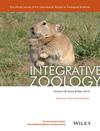多组学揭示中国三江源国家公园小型野生反刍动物肠道微生物群介导的严峻觅食环境适应性
IF 3.5
1区 生物学
Q1 ZOOLOGY
引用次数: 0
摘要
藏羚羊(Pantholops hodgsonii)、青羊(Pseudois nayaur)和藏绵羊(Ovis aries)是三江源国家公园(TRSNP)中最主要的小型反刍动物。然而,人们对肠道微生物群与宿主适应性之间的关系仍然知之甚少。本文采用多组学测序方法研究了这些反刍动物肠道微生物群介导的饲草适应性。结果发现,虽然P. hodgsoni和P. nayaur的野生反刍动物(WR)面临着植被覆盖率和营养水平明显偏低的恶劣觅食环境,但其干物质、粗蛋白和酸性洗涤纤维的表观饲草消化率却明显高于O. aries。16s rRNA测序结果表明,WR的肠道微生物群经历了趋同进化,其α多样性明显高于白羊座。此外,指示物种(包括类杆菌和固形菌)与表观饲草消化率呈正相关,其相对丰度在小羊肠道中富集。肠型分析进一步发现,肠型1属于WR,脂肪酸合成代谢途径相关酶基因的丰度明显高于以白羊座O.为代表的肠型2。此外,元基因组分析还发现了 14 种致病菌,其中 10 种潜在致病菌在白鲑鱼肠道微生物群中明显富集。此外,纤维素分解菌株以及编码纤维素酶和半纤维素酶的基因在 WR 中明显富集。总之,我们的研究结果提供了新的证据,证明肠道微生物群能促进野生动物在中国大西北地区恶劣觅食环境中的适应。本文章由计算机程序翻译,如有差异,请以英文原文为准。
Multi‐omics reveal the gut microbiota‐mediated severe foraging environment adaption of small wild ruminants in the Three‐River‐Source National Park, China
The Tibetan antelope (Pantholops hodgsonii ), blue sheep (Pseudois nayaur) , and Tibetan sheep (Ovis aries ) are the dominant small ruminants in the Three‐River‐Source National Park (TRSNP). However, knowledge about the association between gut microbiota and host adaptability remains poorly understood. Herein, multi‐omics sequencing approaches were employed to investigate the gut microbiota‐mediated forage adaption in these ruminants. The results revealed that although wild ruminants (WR) of P . hodgsoni and P. nayaur were faced with severe foraging environments with significantly low vegetation coverage and nutrition, the apparent forage digestibility of dry matter, crude protein, and acid detergent fiber was significantly higher than that of O. aries . The 16s rRNA sequencing showed that the gut microbiota in WR underwent convergent evolution, and alpha diversity in these two groups was significantly higher than that in O. aries . Moreover, indicator species, including Bacteroidetes and Firmicutes, exhibited positive relationships with apparent forage digestibility, and their relative abundances were enriched in the gut of WR. Enterotype analysis further revealed that enterotype 1 belonged to WR, and the abundance of fatty acid synthesis metabolic pathway‐related enzyme genes was significantly higher than enterotype 2, represented by O. aries . Besides, the metagenomic analysis identified 14 pathogenic bacterial species, among which 10 potentially pathogenic bacteria were significantly enriched in the gut microbiota of O. aries . Furthermore, the cellulolytic strains and genes encoding cellulase and hemicellulase were significantly enriched in WR. In conclusion, our results provide new evidence of gut microbiota to facilitate wildlife adaption in severe foraging environments of the TRSNP, China.
求助全文
通过发布文献求助,成功后即可免费获取论文全文。
去求助
来源期刊

Integrative zoology
ZOOLOGY-
CiteScore
6.40
自引率
12.10%
发文量
81
审稿时长
>12 weeks
期刊介绍:
The official journal of the International Society of Zoological Sciences focuses on zoology as an integrative discipline encompassing all aspects of animal life. It presents a broader perspective of many levels of zoological inquiry, both spatial and temporal, and encourages cooperation between zoology and other disciplines including, but not limited to, physics, computer science, social science, ethics, teaching, paleontology, molecular biology, physiology, behavior, ecology and the built environment. It also looks at the animal-human interaction through exploring animal-plant interactions, microbe/pathogen effects and global changes on the environment and human society.
Integrative topics of greatest interest to INZ include:
(1) Animals & climate change
(2) Animals & pollution
(3) Animals & infectious diseases
(4) Animals & biological invasions
(5) Animal-plant interactions
(6) Zoogeography & paleontology
(7) Neurons, genes & behavior
(8) Molecular ecology & evolution
(9) Physiological adaptations
 求助内容:
求助内容: 应助结果提醒方式:
应助结果提醒方式:


